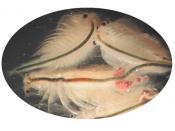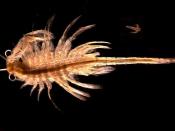Abstract:Rotifers (Brachionus plicatilis) and brine shrimp (Artemia) are essential live feeds for marine fish and crustacean hatchery aquaculture worldwide. However, these have low content of highly unsaturated fatty acids (HUFA), in particular eicosapentaenoic acid (EPA) and docosahexaenoid aicd (DHA), and must be enriched prior being fed to the larvae. In this experiment, microencapsulated enriching diets were prepared using a black colour stain cod liver oil which was high on HUFA, and finally fed to rotifers and Artemia nauplii for 1 hour. The gut content of the rotifers and Artemia were examined under a microscope after this period to observed the position of the ingested stained microcapsules.
Introduction:Live foods such as rotifers (Brachionus plicatilis) and brine shrimp (Artemia sp.) are still essential for mass culture of larvae in the aquaculture industry, in particular to larvae of marine fish and crustaceans (Lemm & Lemarie, 1991; Southgate & Lou, 1995; Fernandez-Reiriz et al.,
1998; Navarro et al., 1999; Han et al., 2000; Tonhein et al., 2000; Ando et al., 2004; Aragao et al., 2004; Ritar et al., 2004). The use of rotifers and Artemia is primarily because they are very convenient to use and are readily available (McEvoy et al., 1995). Since no artificial feed formulation is yet available to completely substitute live feeds, feeding rotifers and Artemia to young fish larvae still remains essential in commercial hatchery operations (Sorgeloos et al., 2001). However, there is extended research of rotifers and many Artemia strains being deficient in the highly unsaturated fatty acids (HUFA) eicosapentaenoic acid 20:5n-3 (EPA) and docosahexaenoid acid 22:6n-3 (DHA), which are both essential for normal growth and development of crustacean and marine fish larvae, and must be provided in the diet (Walford & Lam, 1987; Dhert et al. 1990; Rees et al., 1994;...


